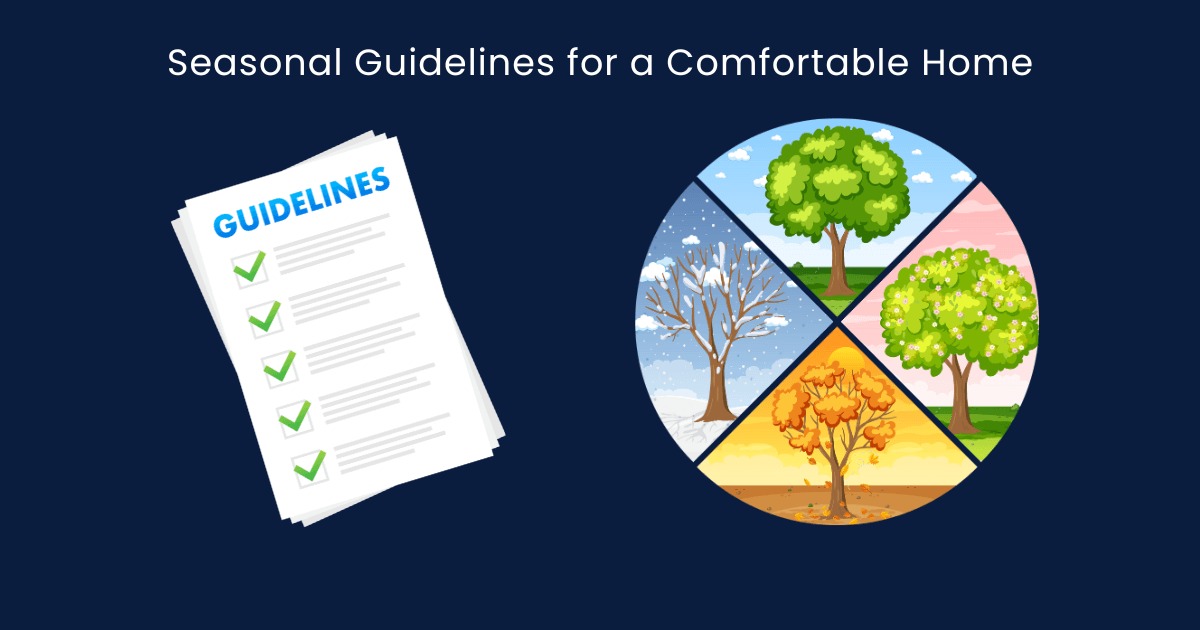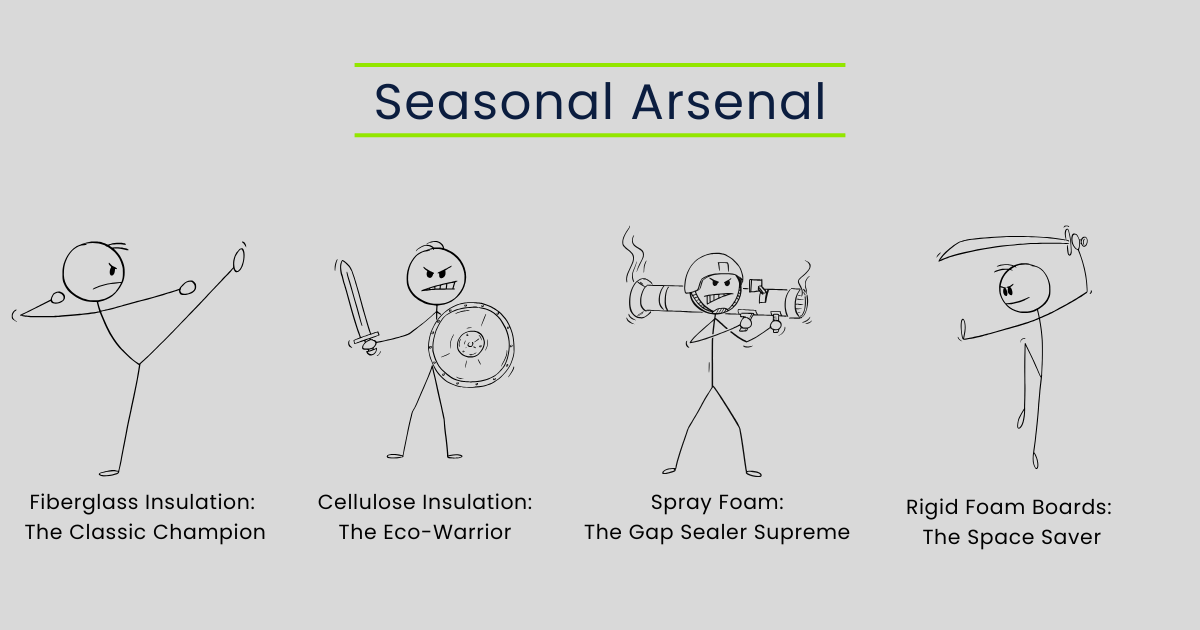Seasonal Insulation: Your Year-Round Guide to Home Comfort
Ever notice how your home feels like it's playing weather roulette throughout the year? One minute you're wrapped in blankets, the next you're competing with your dog for the coolest spot on the tile floor. If this sounds familiar, let's talk about seasonal insulation and how it can transform your home into a comforting paradise all year long.
The Dance of the Seasons: How Insulation Works Year-Round
Think of insulation like your home's personal meteorologist and bouncer combined. Just as a bouncer controls who gets into the club, insulation controls heat flow in and out of your home. In winter, it keeps the warm air inside where it belongs. During summer, it shows the hot air the door.
Let's break down how insulation works through the seasons:
Spring Awakening: Managing Temperature Swings
Spring is like that friend who can't make up their mind - one day it's warm, the next it's chilly. Your insulation helps by:
Regulating heat flow during temperature fluctuations
Preventing warm air from escaping during those surprise cold snaps
Managing moisture as snow melts and rain showers hit
Maintaining consistent indoor temperatures despite outdoor changes
Summer Comfort: Managing Heat Gain
During the cold months, your heating system works hard to keep your living space toasty. Without proper insulation, that precious heat might as well be doing the cha-cha right out of your walls! Here's what happens:
Heat flow naturally moves from warm areas to cold ones
A well insulated home acts like a thermal fortress, keeping warm air inside
Good insulation reduces the workload on your heating system
Less energy used means lower heating and cooling costs
Summer Shields: Managing Heat Gain
When summer rolls around, your home faces a different challenge. Here's where seasonal insulation really shows its versatility:
Insulation materials work overtime to slow heat transfer from the outside
Your cooling system doesn't have to fight as hard to maintain consistent indoor temperatures
Air conditioning costs drop significantly with proper insulation
Attic insulation becomes your best friend in preventing hot air from cooking your upper floors
Fall Preparation: Getting Ready for Winter
Fall is your home's preparation season - think of it as your insulation's pre-game warmup. During these months:
Properly insulating your home helps maintain warmth as temperatures start to drop
Good insulation prevents heat loss through walls and attics
Your heating system can ease into its winter workload
Air sealing combined with insulation stops those chilly autumn drafts
Winter Warriors: Battling Heat Loss: Understanding Insulation Performance
Let's talk about R-value – your insulation's superhero cape. The higher the R-value, the better your insulation materials are at fighting heat flow. Different areas of your home need different R-values:
Attics typically need R-values between R-30 and R-60
Walls usually require R-13 to R-21
Floors might need R-13 to R-30
Think of R-value like your coffee thermos's ability to keep your drink hot or cold. The better the thermos (higher R-value), the longer your drink stays at the perfect temperature.
The R-Value Revolution: Understanding Insulation Performance
Let's talk about R-value – your insulation's superhero cape. The higher the R-value, the better your insulation materials are at fighting heat flow. Different areas of your home need different R-values:
Attics typically need R-values between R-30 and R-60
Walls usually require R-13 to R-21
Floors might need R-13 to R-30
Think of R-value like your coffee thermos's ability to keep your drink hot or cold. The better the thermos (higher R-value), the longer your drink stays at the perfect temperature.
Types of Insulation: Your Seasonal Arsenal
Different insulation materials bring different benefits to the table:
Fiberglass Insulation: The Classic Champion
Budget-friendly and effective
Perfect for maintaining consistent temperatures
Great for both new construction and adding insulation to existing homes
Cellulose Insulation: The Eco-Warrior
Made from recycled materials
Superior at sealing gaps and preventing air leaks
Excellent for reducing energy bills
Spray Foam: The Gap Sealer Supreme
Creates an airtight seal
Outstanding at stopping heat flow
Ideal for hard-to-reach spaces and crawl spaces
Rigid Foam Boards: The Space Saver
High R-value per inch
Perfect for areas where space is tight
Great at preventing thermal bridging
The Year-Round Benefits: Beyond Temperature Control
You might think insulation is just about keeping warm in winter and cool in summer, but that's like saying a smartphone is just for making calls. Your home's insulation is actually a multitasking marvel that works harder than a coffee shop barista during the morning rush hour. Beyond maintaining those perfect indoor temperatures, quality insulation brings a whole menu of benefits that make your home more comfortable, efficient, and enjoyable throughout the year.
Let's dive into the surprising ways proper insulation transforms your living space into a year-round comfort zone. These benefits work together like a well-orchestrated symphony, each playing its part in creating the perfect home environment:
Sound Control
Reduces outside noise by up to 50%
Creates a peaceful living space
Especially helpful in busy neighborhoods
Moisture Management
Helps prevent mold growth
Protects other building materials
Maintains healthy indoor air quality
Energy Efficiency
Significant reduction in energy usage
Lower energy bills throughout the year
Smaller carbon footprint
Seasonal Maintenance Tips for Optimal Performance
Just like your car needs different types of care throughout the year, your home's insulation has seasonal needs too. Think of it as giving your home a quarterly health check-up. Each season brings unique challenges that can impact your insulation's performance and your home's energy efficiency.
Many homeowners ask us, "Do I really need to check my insulation that often?" Well, imagine wearing the same winter coat for years without ever checking for tears or washing it - eventually, it wouldn't keep you as warm, right? Your home's insulation is like that coat, but for your entire house. Regular maintenance helps catch small issues before they become big problems, keeping your energy bills low and your comfort level high.
Here's your season-by-season guide to keeping your insulation in top shape. We've broken it down into simple, manageable tasks that even the busiest homeowner can handle:
Spring Maintenance: The Post-Winter Checkup
As nature wakes up from winter, it's time to assess how your insulation handled the cold months. Spring's moderate temperatures make it the perfect time to check for winter damage and prepare for the warming months ahead. Your main focus should be on moisture control and repair work - after all, April showers might bring May flowers, but they shouldn't bring water damage to your insulation!
Inspect insulation for winter damage
Check for moisture issues in attics and crawl spaces
Look for signs of pest intrusion
Test indoor air quality as windows open more
Verify proper ventilation is working
Summer Maintenance: Beat the Heat
Summer is when your insulation plays defense against the scorching heat. This is also the easiest time to access and inspect your attic insulation (preferably during the cooler morning hours - trust us on this one!). Your goal is to ensure your home's cooling system isn't working harder than necessary to maintain those comfortable indoor temperatures.
Inspect attic insulation for proper coverage
Check that radiant barriers are intact
Ensure ventilation systems are clear
Monitor indoor temperatures across floors
Look for signs of air conditioning overwork
Fall Maintenance: Preparing for Winter's Challenge
Fall is your insulation's prep season - think of it as getting your home's winter coat ready. This is the perfect time to address any issues you noticed during summer and batten down the hatches before winter arrives. A little effort now can make a big difference in your winter comfort and energy bills.
Seal any air leaks before cold weather arrives
Add insulation to areas that felt too warm in summer
Check weatherstripping around doors and windows
Insulate pipes that might be exposed to cold
Verify that heating systems can perform efficiently
Winter Maintenance: Keeping Cozy and Efficient
Winter is when your insulation really earns its keep. While it's not the ideal time for major insulation projects, it's perfect for monitoring performance and catching any issues early. Pay special attention to how your home maintains heat and watch for signs that might indicate insulation problems.
Monitor for ice dams and heat loss signs
Check insulation in easily accessible areas
Look for cold spots that might indicate insulation gaps
Observe snow melt patterns on your roof
Keep an eye on energy bills for sudden changes
Investment That Pays You Back: The Numbers Don't Lie
Let's talk about turning your insulation project into a money-making machine (okay, maybe not quite a machine, but definitely a smart financial move!). When you're properly insulating your home, you're not just spending money - you're investing in long-term savings and comfort.
Immediate Impact on Energy Bills
Average savings of 15-20% on heating and cooling costs
Reduction in both heating system and cooling system workload
Less energy usage means lower monthly bills year-round
Many homeowners report a 30% decrease in energy costs after addressing air leaks and adding insulation
Long-Term Financial Benefits
Superior insulation can last 20-40 years with proper maintenance
A well insulated home typically sells faster and at a better price
Reduced wear and tear on your HVAC system means fewer repair bills
Protection of other building materials from moisture damage saves on future repairs
Government Incentives and Tax Benefits
Energy Efficient Home Improvement Credit offers up to $1,200 in tax credits
The credit equals 30% of your total cost for energy efficiency upgrades
Additional state and local rebates may be available for improving home energy efficiency
Some utility companies offer incentives for insulation upgrades that reduce energy usage
Less dust means fewer air filter replacements
Better temperature control can extend the life of your electronics and appliances
Consistent indoor temperatures reduce food spoilage in pantries
Lower maintenance costs for your heating and cooling systems
Improved indoor air quality could mean fewer allergy-related expenses
For more information on how to get these tax benefits, check out our post 2025 Insulation Tax Credit Explained: Your Step-by-Step Money-Saving Guide Hidden Savings You Might Not Expect (add link)
Return on Investment Timeline
Most homeowners start seeing energy savings immediately
Initial investment typically pays for itself within 3-5 years
A properly insulated home continues generating savings throughout the year
Energy costs tend to rise over time, making your insulation investment even more valuable
Real Numbers from Real Homes
Let's break down what this means for a typical 2,000 square foot home:
Before proper insulation: $350/month average for heating and cooling
After adding insulation: $245/month average
Annual savings: $1,260
10-year savings: $12,600 (not counting energy price increases!)
Additional savings from reduced HVAC maintenance: $200-400 annually
Remember: These numbers are averages - your actual savings could be even higher depending on your current insulation status, local climate, and energy rates. The best way to get an accurate estimate for your home? Schedule a free consultation with our team. We'll help you crunch the numbers and find the perfect insulation solution for your budget and needs.
Your Year-Round Comfort Awaits
Think of insulation as your home's Swiss Army knife of savings - it's working 24/7, through every season, to keep your living space comfortable while protecting your wallet. From those scorching summer days to freezing winter nights, proper insulation is the unsung hero of home comfort.
Remember, seasonal insulation isn't just about staying cozy - it's a smart investment that keeps giving back year after year. Whether you're looking to lower heating and cooling costs, maintain consistent indoor temperatures, or boost your home's value, the right insulation strategy makes all the difference.
Here at Argyle Bros Insulation, we've seen countless homes transformed from energy-guzzling spaces into efficient, comfortable havens. Every home is unique - like a fingerprint, but bigger and with more rooms to keep comfortable. That's why we take pride in creating customized insulation solutions that work for your specific needs and budget.
Ready to start your journey toward year-round comfort and energy savings? Give us a call! We'll help you create the perfect balance of seasonal protection and cost efficiency. From selecting the right insulation materials to ensuring optimal performance through every season, we're here to help you make your home the comfortable, efficient space you deserve.
Because at the end of the day, a well insulated home isn't just about the numbers - it's about creating a space where your family can thrive, regardless of what Mother Nature throws your way!
Transform your home’s comfort today!








